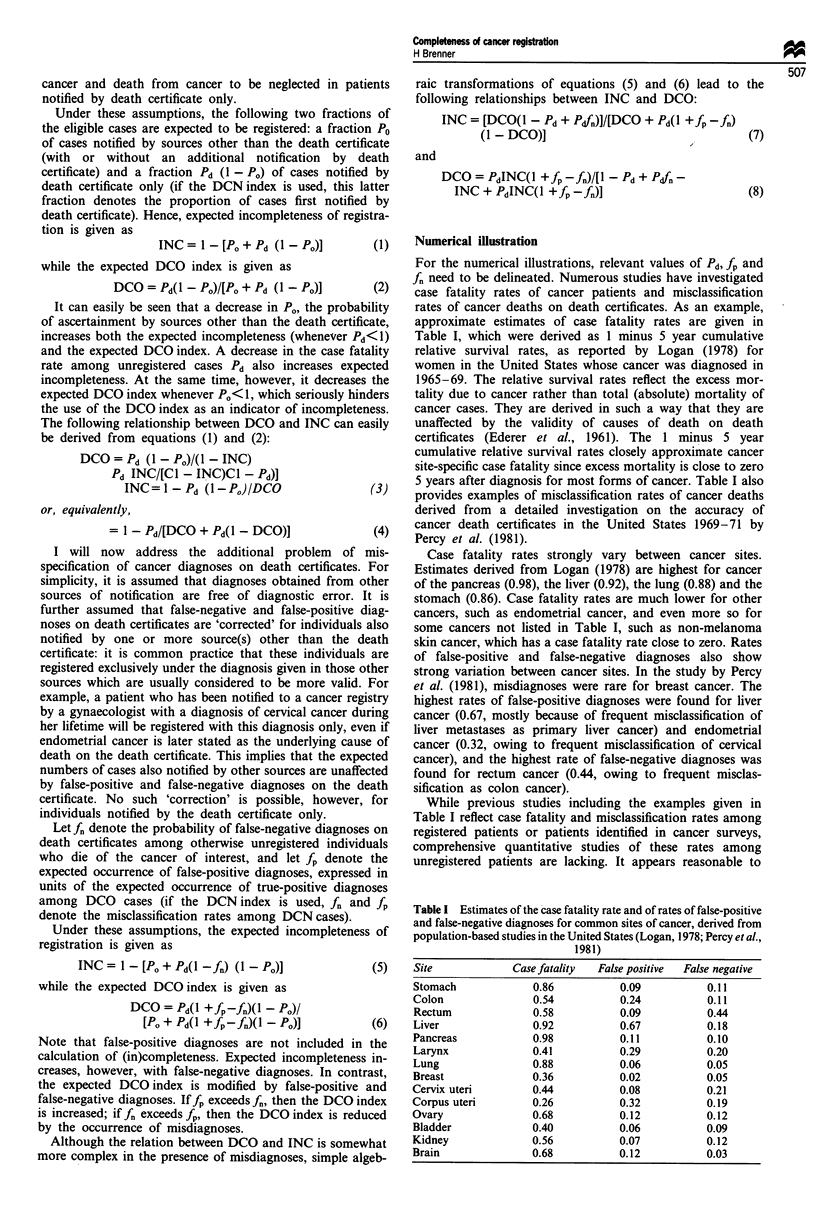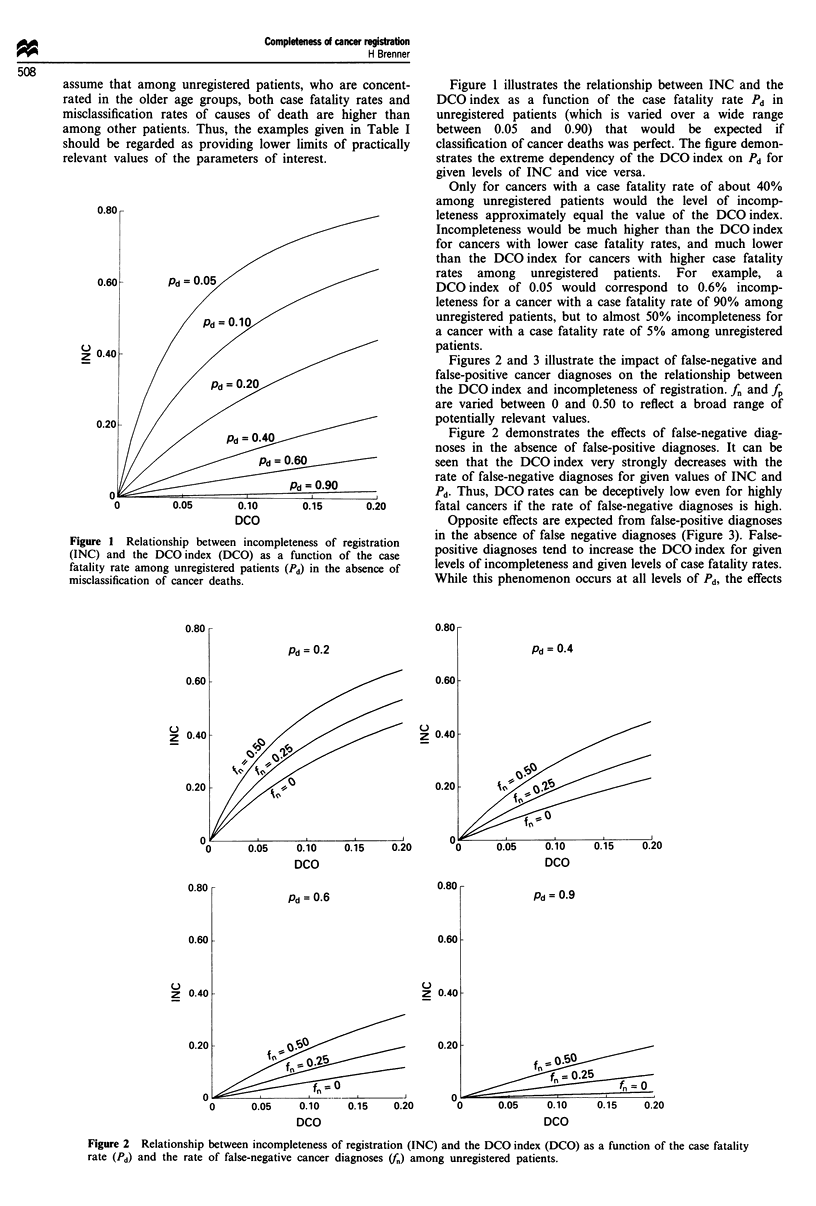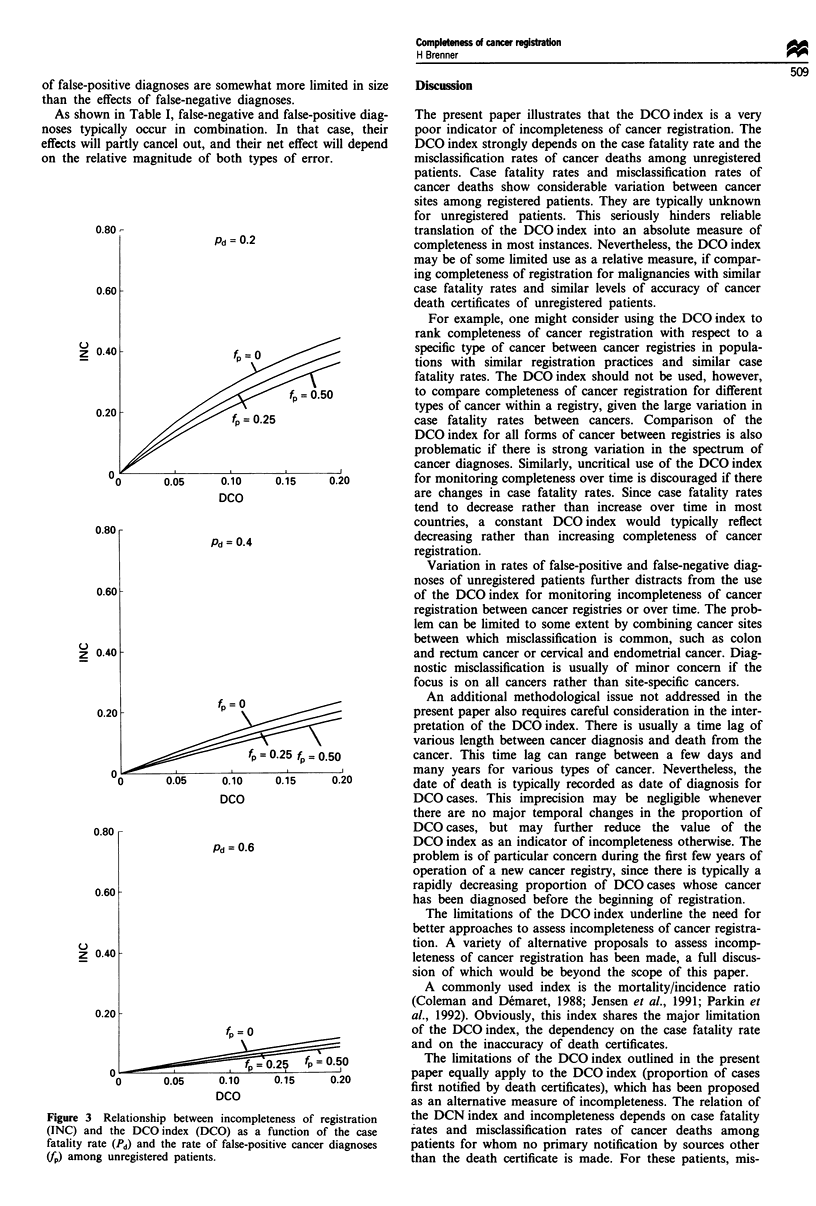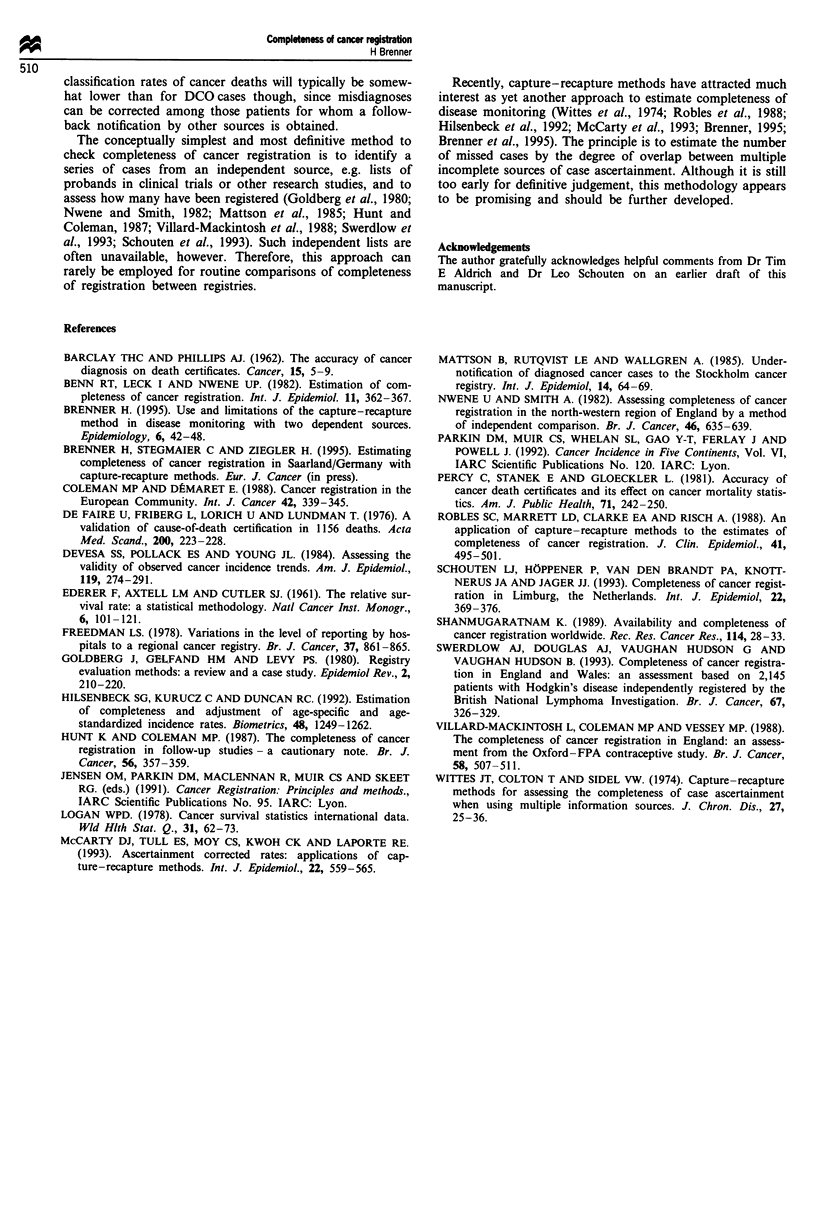Abstract
The death certificate only (DCO) index, which quantifies the proportion of patients for whom the death certificate provides the only notification to the registry, is a widely used measure of incompleteness of population-based cancer registration. This paper provides an algebraic assessment and a quantitative illustration of the relationship between the DCO index and incompleteness of cancer registration. It is shown that the relationship between the DCO index and incompleteness of registration is strongly dependent on the case fatality rate and the misclassification rates of cancer deaths among unregistered patients. Therefore, the DCO index is a very poor indicator of incompleteness. Similar limitations apply to the DCN index (proportion of cases first notified by death certificate), which has been proposed as an alternative measure of incompleteness.
Full text
PDF




Selected References
These references are in PubMed. This may not be the complete list of references from this article.
- Benn R. T., Leck I., Nwene U. P. Estimation of completeness of cancer registration. Int J Epidemiol. 1982 Dec;11(4):362–367. doi: 10.1093/ije/11.4.362. [DOI] [PubMed] [Google Scholar]
- Brenner H. Use and limitations of the capture-recapture method in disease monitoring with two dependent sources. Epidemiology. 1995 Jan;6(1):42–48. doi: 10.1097/00001648-199501000-00009. [DOI] [PubMed] [Google Scholar]
- Coleman M. P., Démaret E. Cancer registration in the European community. Int J Cancer. 1988 Sep 15;42(3):339–345. doi: 10.1002/ijc.2910420306. [DOI] [PubMed] [Google Scholar]
- Devesa S. S., Pollack E. S., Young J. L., Jr Assessing the validity of observed cancer incidence trends. Am J Epidemiol. 1984 Feb;119(2):274–291. doi: 10.1093/oxfordjournals.aje.a113746. [DOI] [PubMed] [Google Scholar]
- EDERER F., AXTELL L. M., CUTLER S. J. The relative survival rate: a statistical methodology. Natl Cancer Inst Monogr. 1961 Sep;6:101–121. [PubMed] [Google Scholar]
- Freedman L. S. Variations in the level of reporting by hospitals to a regional cancer registry. Br J Cancer. 1978 May;37(5):861–865. doi: 10.1038/bjc.1978.126. [DOI] [PMC free article] [PubMed] [Google Scholar]
- Goldberg J., Gelfand H. M., Levy P. S. Registry evaluation methods: a review and case study. Epidemiol Rev. 1980;2:210–220. doi: 10.1093/oxfordjournals.epirev.a036224. [DOI] [PubMed] [Google Scholar]
- Hilsenbeck S. G., Kurucz C., Duncan R. C. Estimation of completeness and adjustment of age-specific and age-standardized incidence rates. Biometrics. 1992 Dec;48(4):1249–1262. [PubMed] [Google Scholar]
- Hunt K., Coleman M. P. The completeness of cancer registration in follow-up studies--a cautionary note. Br J Cancer. 1987 Sep;56(3):357–359. doi: 10.1038/bjc.1987.202. [DOI] [PMC free article] [PubMed] [Google Scholar]
- Logan W. P. Cancer survival statistics; international data. World Health Stat Q. 1978;31(1):62–73. [PubMed] [Google Scholar]
- Mattsson B., Rutqvist L. E., Wallgren A. Undernotification of diagnosed cancer cases to the Stockholm Cancer Registry. Int J Epidemiol. 1985 Mar;14(1):64–69. doi: 10.1093/ije/14.1.64. [DOI] [PubMed] [Google Scholar]
- McCarty D. J., Tull E. S., Moy C. S., Kwoh C. K., LaPorte R. E. Ascertainment corrected rates: applications of capture-recapture methods. Int J Epidemiol. 1993 Jun;22(3):559–565. doi: 10.1093/ije/22.3.559. [DOI] [PubMed] [Google Scholar]
- Nwene U., Smith A. Assessing completeness of cancer registration in the north-western region of England by a method of independent comparison. Br J Cancer. 1982 Oct;46(4):635–639. doi: 10.1038/bjc.1982.248. [DOI] [PMC free article] [PubMed] [Google Scholar]
- Percy C., Stanek E., 3rd, Gloeckler L. Accuracy of cancer death certificates and its effect on cancer mortality statistics. Am J Public Health. 1981 Mar;71(3):242–250. doi: 10.2105/ajph.71.3.242. [DOI] [PMC free article] [PubMed] [Google Scholar]
- Robles S. C., Marrett L. D., Clarke E. A., Risch H. A. An application of capture-recapture methods to the estimation of completeness of cancer registration. J Clin Epidemiol. 1988;41(5):495–501. doi: 10.1016/0895-4356(88)90052-2. [DOI] [PubMed] [Google Scholar]
- Schouten L. J., Höppener P., van den Brandt P. A., Knottnerus J. A., Jager J. J. Completeness of cancer registration in Limburg, The Netherlands. Int J Epidemiol. 1993 Jun;22(3):369–376. doi: 10.1093/ije/22.3.369. [DOI] [PubMed] [Google Scholar]
- Shanmugaratnam K. Availability and completeness of cancer registration worldwide. Recent Results Cancer Res. 1989;114:28–33. doi: 10.1007/978-3-642-83651-0_3. [DOI] [PubMed] [Google Scholar]
- Swerdlow A. J., Douglas A. J., Vaughan Hudson G., Vaughan Hudson B. Completeness of cancer registration in England and Wales: an assessment based on 2,145 patients with Hodgkin's disease independently registered by the British National Lymphoma Investigation. Br J Cancer. 1993 Feb;67(2):326–329. doi: 10.1038/bjc.1993.60. [DOI] [PMC free article] [PubMed] [Google Scholar]
- Villard-Mackintosh L., Coleman M. P., Vessey M. P. The completeness of cancer registration in England: an assessment from the Oxford-FPA contraceptive study. Br J Cancer. 1988 Oct;58(4):507–511. doi: 10.1038/bjc.1988.252. [DOI] [PMC free article] [PubMed] [Google Scholar]
- Wittes J. T., Colton T., Sidel V. W. Capture-recapture methods for assessing the completeness of case ascertainment when using multiple information sources. J Chronic Dis. 1974 Feb;27(1):25–36. doi: 10.1016/0021-9681(74)90005-8. [DOI] [PubMed] [Google Scholar]
- de Faire U., Friberg L., Lorich U., Lundman T. A validation of cause-of-death certification in 1,156 deaths. Acta Med Scand. 1976;200(3):223–228. doi: 10.1111/j.0954-6820.1976.tb08223.x. [DOI] [PubMed] [Google Scholar]


